PRE2017 1 Groep1: Difference between revisions
| Line 189: | Line 189: | ||
*Crowd Management | *Crowd Management | ||
** | ** | ||
Robot utility in riots | *Robot utility in riots | ||
** | ** | ||
Revision as of 11:03, 21 September 2017
| Members of group 1 | |
| Bern Klein Holkenborg, Mechanical Engineer | |
| Sjoerd van Heesbeen, Mathematician | |
| Luke van Unen, Software Scientist | |
Introduction
In this project, problems are solved from a societal perspective. Engineers usually look at engineering problems, but fail to notice that either the problem is of no issue for the user or society, or the problem may be irrelevant for the problem the user or society has. This project explores the utility of just that: looking from a user's need. For the course a problem is posed which is be detailed below.
Problem Definition
The world is more populated than it ever has been, and so is the Netherlands. With as much as seventeen million people to govern, control and live is difficult and tranlate to many issues. Society is build from many different people with own ideals, ideas and way of living. Friction between people or friction between them and the law is more common the more people there are, and now with more people than ever this is a real issue. The police force acting as a regulator for these problems contributes a significant factor in deminishing the problems arraising from society. However, the police has issues growing in effective employees to regulate the society, due to management problems and financial problems. Historically, problems with too few (or too much) personell has been solved by automation. So why is the police force not as automated as it maybe should be? In the past, these automated problems were often repetetive or non-complicated, whereas a police task is hugely complex: Every situation is different, there are safety concerns and the police works with humans, not objects.
Objective
As described above, to keep up with population growth, the police force has to evolve to a (partly) automated force. The objective for the project is just that. A robot should be created to automate an otherwise employee intensive police task. This without bringing user or society in harm. The robot should be save to interact with, useful and should be able to cope with every situation it faces. Already there are real police robots wandering in the streets (Dubai), however they often lack in almost every situation compared to human officer. The goal of the project would be far to enthusiastic to design such a robot. In this project, a specific police task will be tackled. To define this better, a few examples: Speeding control, a mobile robot could check wherever, whenever for speeds. An automated alchohol check can be done, a robot could be set up to automatically check if a driver is allowed to drive or not. A robot that monitors a vehicle chase, a mobile robot unit will likely be faster, cheaper and more varsetile than a police helicopter will ever be. The specific police task tackled will be chosen later based on an interview with the police.
Approach
To tackle the best problem, it has to be investigated how and why a police task is done and how this could be automated. An interview with the police should clearify both that, and should also narrow down the problem to a single task. The task should be investigated in detail. As before, why and how is it done, what rules are there, what is to be kept in mind during the task, how do people react to the task, is it safe to automate it in the proposed method. When all the parameters are defined, a robot can be designed both technically and functionally. After designing the robot, the design has to be verified by both the police and users which can be done by enquete, interview and maybe even a prototype test.
USE
User aspect
While dealing with police work, there are two users involved. First, obviously, is the police itself, they have to use the robot that we are going to design. The police has some special needs and wishes, therefore we are going to discuss with them about what they want and what we can offer them. This will be the main focus of our project. The robot will also have to deal with persons, so they are also a user, they must have a safe feeling through the presence of these robots, next to that the troublemakers must be handled with care, there are some rulings about that.
Society aspect
This robot will have a positive influence on the society, riots will be easier dealt with and hopefully less people will get hurt. But the society is also something to take in mind as they have to assess the actions of the robot. The robot must act with justice, he must have a good reason to harm people or any other action involving people. This part will be elaborately handled in this report, as there are a lot of ethical rules and there are different ways to applicate them.
Enterprise aspect
The enterprise aspect of our design can handled in two ways, the first one is that the police continues on the design of the robot as there will be a lot left to do research on and to develop. The second option is that a particular will continue the design and they will sell it to the police corps. We will not focus on the enterprise while the other aspects are more interesting and there is still a lot to develop.
Functional Investigation
State of the Art
Crowd control has been an issue for decades. There is less chance of being arrested in a large group of people, thus naturally, crowds often are unpredictable and violent for the environment and crowd control force. And since there are a lot of people now, and in the past, sharing a common thought, crowds gathering is of daily occurence. Because of this, researchers and engineers have already tried to investigate how to minimise damage of such crowds by optimising crowd control techniques and preventing crowds from harming the controlling agents by, for example replacing the human agents with robotic ones. An analysis of such robotic crowd control techniques is presented here to investigate different techniques, possibilities and tricks to keep in mind for the design of our own robot.
Drivetrain
Segway RMP440
The Segway RMP440 is a 4 wheel off-road flexible transportation robot. The Segway RMP440 is designed so it can navigate loose, rough and steep terrain. It does that with this 4 big wheels, driven by a powerful DC motor per wheel, allowing it to drive upto 29km/h and deliver 100N-m torque. It can drive through 250mm of water and traverse slopes of 30 degrees. It is controlled by user input from control software from a PC. The robot is designed to handle 90kg of payload through rough terrain. The type of payload is upto the user, this can vary from carrying equipment upto weapons (or waterguns as seen in the figure below). The battery lasts 8 hours at operating power.
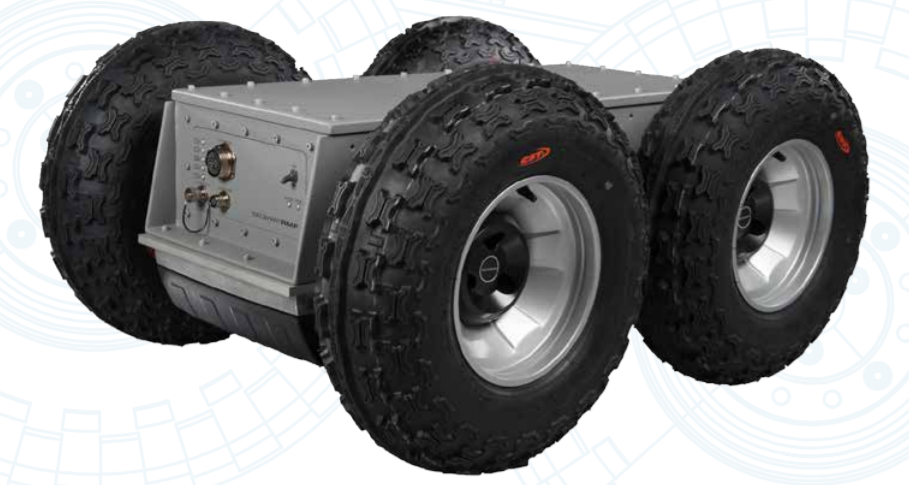 |
 |
The Segway RMP440 is in many ways effective for the goal we set for crowd control management. The robot is powerful, can drive fast, though rough terrain, lasts long, is strong, and most importantly: it is flexible. It can be mounted with waterguns, shields, guns or any other tool needed for crowdcontrol. Also, the cost is relatively low since the design does not include really advanced hardware. This relatively low cost is important: When multiple robots are purchased and then set up to connect to each other, these things could be driven by an autonoum program that navigates multiple of these robots simultaniously, performing known crowd control techniques for optimal crowd control. Since the control software is already written, it would only have to be modified and adapted for autonomous control.
Endeavor Robotics Kobra
The Kobra from Endeavor Robotics is like the Segway RMP440 an off-road flexible transportation robot. From their specification sheet:
The Kobra was designed to provide unmatched strength, power and payload support in an easy to operate robot package. Kobra has a lift capacity of 330 pounds (150 kg) and integrates numerous payloads to expand your operational area. Kobra can reach over 11.5’ feet (3.5 m), easily climb stairs, fit through doorways or down aisle-ways and store or deploy directly from the back of a small 4x4 vehicle. Able to achieve sustained speeds of 8 mph (12.9 km/h) while carrying 150-pound payloads, the Kobra maintains mobility on rough terrain in all weather conditions.
It can climb 55 degrees slopes, even steeper than the Segway RMP440. It also comes with four cameras, radio repeater compatible with the Endeavor Robotics software, and can be expanded with multiple accessories, sensors and disruptors (guns). Also it's runtime is 10 hours at operating conditions.
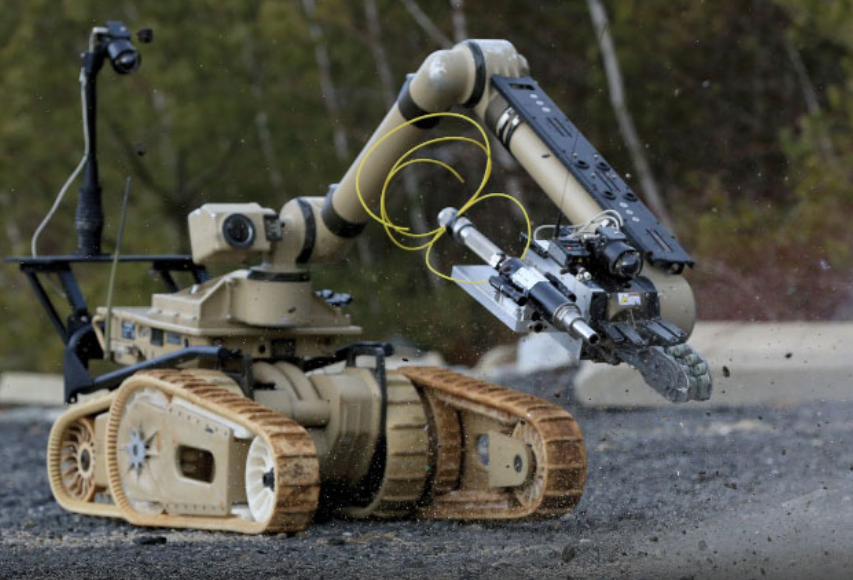 |
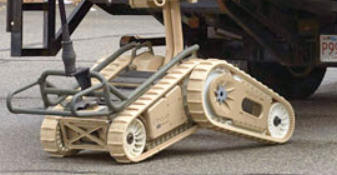 |
What makes this robot especially viable for our goal is the special caterpillar capability illustrated in the figure on the right. The robot has four caterpillars which can move independently. This results in optimal grip on all terrains, can deal with sudden changes in elevation (such as sidewalk curbs). It also enables for flexible movement and zero radius turns.
Evolutionary Artificial Potential Field
This method of robot control focusses on single robot control, but is probably a good option to expand for multiple robot control. The Evolutionary Artificial Potential Field (EAPF) method in general deal with motion planning that includes two different but complementary tasks: plath planning and motion planning. Path planning is responsible for generating a set of positions in the workspace that can drive the robot from it's initial position to the target position. Motion planning takes in account the path plan, but translates this to how the robot should actuate this path.
The EAPF is actually an optimisation of the Artifical Potential Field (APF) method. The APF method is illustrated in the figure below:

The robot in this figure prefers low rather than high potential, thus moves from the right to the left meanwhile avoiding the repulsive pillars. This method seems fine, however there is a massive drawback: the robot could be trapped in a local minimum of potential and get stuck. The problem is the robot checks the potential locally, and when it has navigated to a minimum it has no way of knowing how to proceed since locally, the potential is worse in every direction. This is illustrated in the APF Local Minimum figure.
It also turns out the system has difficulties in dynamic situations where obstacles change position or suddenly appear.
To solve the minimum problem of APF, EAPF was designed. EAPF attaches a cost to the potential. The EAPF method then tries to find a path to the goal that minimizes this cost. Only information on the position of the robot, obstacles and the goal is needed for this method. This way, a global planning is implemented to solve the local planning issue of local minima.
In the paper Optimal Path Planning Generation for Mobile Robots using Parallel Evolutionary Artificial Potential Field cited in the sources chapter, an even better method is proposed which uses the EAPF and adds Generic Algorithms to improve the path planning for dynamic environments with less computational power and a bigger workspace. Experiments in the paper show some promosing results shown in the figures below. The most important thing is that it can handle a dynamic environment, since the crowd control robots will experience this; there is no predefined map of the situation.
 |
 |
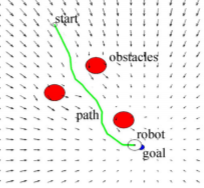 |
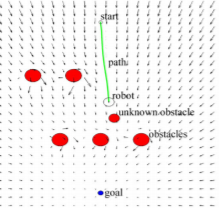 |
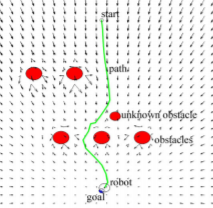 |
Crowd control technique
In the US Army Field Manual, different crowds are described on which to use different tactics. The Manual describes 3 crowd types: Public disorder, Public disturbance and Riot. With Public disorder being non-violent crowds, Public disturbance is where crowds start chanting and singing collective opinions. Some individuals will disturb the normal flow of things. A riot is the most extreme type of crowd, where crowds turn violent and actively try to defeat authorities and the controlling force.
For the control of a crowd, it is important to know it's type so control forces can react accordingly. To identify it's type, background information is needed. An assesment can be made by asking questions:
- Who are they? What is the identity of the crowd? Are they strikers, ethnic factions or social protesters?
- What are their goals?
- What are they capable of doing?
- What are their traditional behaviors?
- When and where will they assemble?
- Where will they go?
- What are the possible targets of violence?
- What is the worst case scenario?
- When and where will they disperse?
Knowing these questions is essential to decide on the tactic to control the crowd with. Too offensive can react to unnecessary violence, whereas too soft can react to an out of control situation.
For a public disorder, often it is enough to stand by and watch for disturbance. Public disturbance and riot often needs more advanced tactics. First of all, when a riot is started, it is important to deter people from joining or leaving the riot. This by for example extensive patrolling, or proclamate the illigality of the riot. Alert, agressive patrolling of the disturbance area deters the gathering of crowds, it also allows for information to be collected, and it creates the psychological impression of the control force being everywhere at once. The use of vehicles provide adds to that effect: The control force is better equipped than the crowd. Varying patrol routes and times keep lawbreakers from being able to pick a safe place or time to act. Proclamating the illigality of the riot makes people aware of the individual and how he is acting illigal. In a crowd, a feeling of shared responsibility causes people to behave different compared to when people are aware of the responsibility they themselves have. Making people aware of themselves and the illigalities they do by proclamation can stop this shared responsibility and deter people. Also warnings can be verbally proclamated like warnings of lootings: "During a disturbance, criminal activity is at it's peak. Your house may be getting looted now, return to your homes!" However, to really try to control the crowd, forces have to either disperse, or contain the crowd.
Containment is the process of limiting a crowd to the area they are presently occupying. It is a suitable option when the crowd must be prevented from spreading to surrounding areas and communities. Perimeter patrols and barriers have to be set up to contain the crowd. However, containment has to be acted upon with caution, to avoid the "fight or flight" syndrome common to people feeling trapped with no escape. Containment contains a lot of coördination. Barriers have to be set up at specified locations. Vehicles or forces have to be traveling at close interval in formation. Dispersion is the process of taking deliberate actions to fragment an assembled crowd in order to prevent the destruction of property or prevent injury. Dispersion is done by proclamations, show of force and moving in crowd control formations. The difficulty of dispersion is channeling the dispersion route. The dispersed crowd should preferably take a chosen route where the crowd can safely and calmly leave the area. Dispersing crowds into wide-open areas for example is unwanted since a new gathering can occur. The crowd should be kept moving, but not too hurried to avoid panic.
This projects opts for Civil Disturbance Formations executed partly by robots. Especially the front of each formation should be operated by robots to minimise damage to the control force. There are different formations (A,B,C, are the squad members, other signs are leaders etc. in the figures below):
- Line formation is the most used formation because it's offensive and defensive applications. As offensive, the line is used to push or drive crowds straight back across an open area or street. Defensive to hold the crowd or deny acces to a certain area.
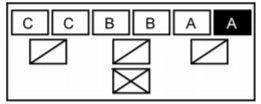
- Echelon formation is an offensive formation to drive crowds away from buldings, fences and walls.

- Wedge formation is an offensive formation to penetrate and split crowds into smaller groups.
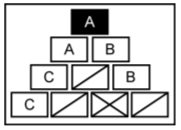
- Diamond formation is a defensive formation that offers all-around security when in an open area.
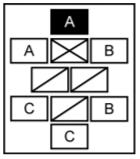
Ideally, the robot designed for this project would be able to execute these formations. The robots should be communicating with eachother sharing location and sensor information to execute this.
Police thoughts
User thoughts
Design
Requirements
To design this kind of robot there are three sorts of requirements that have to be met. First of all the robot needs to meet some technical requirements, it must have the tools to accomplish something. Then there are two sorts of functional requirements, first there are the requirements about the decision making of the robot. Second there are ethical requirements, while there are a lot of ethical rules when you treat with people.
Decision making: During a riot, people must be driven to a safer place, the robot has to make a decision when to push the people and to what place. Therefore the robot need to have contact with the other robots and riot police, together they have to make a choice what the best option is. The robot also need to make decisions when it comes to signaling crimes, so they can arrest them.
Technical requirements: The robot has to sustain a lot of violent people, so it needs to be made out of sustainable, hard materials. Next to that it has to stand solid as people will try to push it over, it must hold over 10 people pushing against the robot. Furthermore it must have the ability to arrest people, so it has to have a mechanism to hold people. For making the decisions the robot must see, it has to have an overview of the situation, it must detect people, actions and safer places.
Ethical requirements: Because you are dealing with people there are a lot of ethical rulings you have to take in mind. You can't assault a troublemaker without any reason, also the means are restricted by these ethics. Shooting is easily ethical irresponsible, you also can't hold a person without reason. These ethical decisions will have to be implemented in the decision making, in a further stage of the project we will discuss the ethical restrictions and possibilities.
Functional
Technical
Validity of design
Police thoughs
User tests
prototype?
Sources
Endeavor Robotics Kobra http://endeavorrobotics.com/products#710-kobra Endeavor Robotics Kobra Spec Sheet http://endeavorrobotics.com/media/docs/English%20Specs/Endeavor%20Robotics%20PackBot%20Spec%20Sheet.pdf Segway RMP440 Spec Sheet http://rmp.segway.com/downloads/RMP440LE.pdf PEAPF Navigation technique https://link-springer-com.dianus.libr.tue.nl/content/pdf/10.1007%2Fs10846-014-0124-8.pdf Crowd Control Technique https://fas.org/irp/doddir/army/fm3-19-15.pdf
1. catagorizeren papers 2. Lezen 3. Probleemstelling opstellen: Waarom is onze robot nodig? 4. Definiëren wat we gaan inleveren/deliveren.
Papers:
- Human Robot Interaction
- Humanoid robots state of the art, and human reaction (book) https://link-springer-com.dianus.libr.tue.nl/content/pdf/bfm%3A978-0-387-85349-9%2F1.pdf
- Psychology of Rioting
- Crowd action as intergroup process: Introducting the police perspective http://onlinelibrary.wiley.com.dianus.libr.tue.nl/doi/10.1002/(SICI)1099-0992(199807/08)28:4%3C509::AID-EJSP877%3E3.0.CO;2-C/abstract
- Conflict escalation
- Riot Simulation
- Crowd Management
- Robot utility in riots